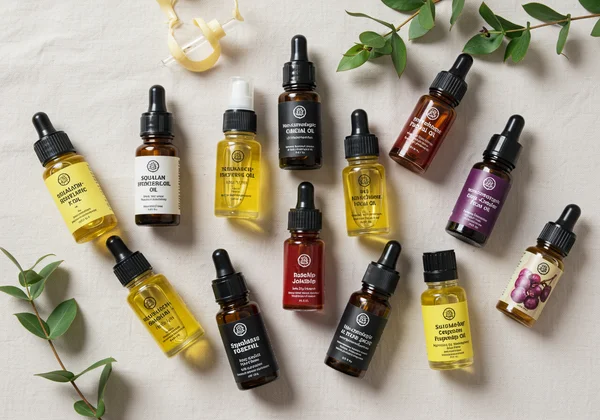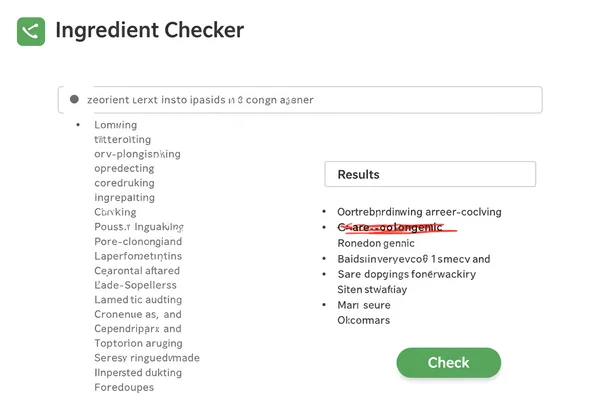Facial Oils for Acne: Your Pore Clogging Ingredient Checker Guide
For anyone dealing with acne-prone skin, the world of skincare often feels like a confusing minefield. The advice you hear is often contradictory. One expert tells you to avoid oils at all costs, while another promotes facial oils for acne as a holy grail solution. So, what's the truth? How do you know which oils will help and which will hurt your skin?
This guide is here to clear up the confusion. We'll dive into the science behind why some oils are breakout triggers while others can be your skin's best friend. More importantly, we'll show you how to take control and make confident choices for your unique skin. Tired of the guesswork? It's time to truly understand what's in your skincare products with our free pore clogging checker.

Understanding Comedogenicity: Your Pore Clogging Oil Checker
The key to unlocking the mystery of facial oils lies in a single concept: comedogenicity. An ingredient is considered "comedogenic" if it has a tendency to clog pores, leading to blackheads, whiteheads, and acne. Non-comedogenic ingredients are much less likely to cause this issue.
But what makes one oil a pore-clogging culprit and another a safe haven for your skin? The answer often lies in its chemical makeup.
The Science Behind Clogged Pores: Fatty Acids and Oxidation
Every natural oil is composed of a unique blend of fatty acids. The two most important ones to know for acne-prone skin are linoleic acid and oleic acid.
- Linoleic Acid: An omega-6 fatty acid, this is a key component of your skin's natural barrier. Studies have shown that people with acne-prone skin often have lower levels of linoleic acid in their sebum (skin oil), which can lead to thicker, stickier oil that clogs pores more easily.
- Oleic Acid: An omega-9 fatty acid, this one is richer and heavier. While beneficial for dry skin, oils high in oleic acid can be problematic for oily and acne-prone types, potentially disrupting the skin barrier and leading to more breakouts.
Generally, oils high in linoleic acid are considered non-comedogenic and beneficial for acne, while those high in oleic acid are more likely to be comedogenic.

How Comedogenic Ratings Are Determined (and Their Limitations)
You may have seen a "comedogenic scale" that rates ingredients from 0 (won't clog pores) to 5 (highly likely to clog pores). This scale was developed based on studies, often done on rabbit ears, in the 1970s. While it provides a helpful starting point, it's not a perfect system.
The concentration of an ingredient in a formula matters, and everyone's skin reacts differently. An oil with a rating of 2 might be perfectly fine for one person but cause breakouts in another. This is why personal testing and ingredient awareness are so crucial. Instead of memorizing a list, using a smart skincare ingredient checker is a far more effective strategy.
Non-Comedogenic Oils: Your Acne-Safe Allies
Now for the good news! Many oils are fantastic for acne-prone skin. They can help balance your skin's oil production, provide anti-inflammatory benefits, and strengthen your skin barrier without causing congestion. These are the oils that don't clog pores and can become staples in your routine.
Top 5 Acne-Safe Facial Oils & Their Benefits
Here are some of the best non-comedogenic oils that are generally considered safe and beneficial for those struggling with breakouts:
-
Squalane Oil: Extremely lightweight and similar to the skin's natural sebum, it moisturizes without feeling greasy. It's a stable oil with a comedogenic rating of 0-1.
-
Hemp Seed Oil: Rich in linoleic acid, it's a powerhouse for calming inflammation and regulating oil production. It has a comedogenic rating of 0.
-
Rosehip Seed Oil: Packed with vitamins A and C and linoleic acid, it helps with cell turnover and fading acne scars. Its comedogenic rating is 1.
-
Jojoba Oil: Structurally very similar to human sebum, it can help trick the skin into producing less oil. It has a comedogenic rating of 2 but is well-tolerated by most.
-
Grapeseed Oil: Another lightweight oil high in linoleic acid, it has antioxidant and antimicrobial properties, making it great for acne-prone skin. Its comedogenic rating is 1.

How to Introduce New Oils into Your Routine
Even with "safe" oils, caution is key. Always patch-test a new product on a small, discreet area of your skin (like behind your ear or on your jawline) for a few days. This helps ensure you don't have an adverse reaction before applying it all over your face. Start by using just a few drops at night as the last step in your routine.
The Culprits: Facial Oils That Clog Pores
Just as there are heroes, there are villains in the world of facial oils. Some are notorious for causing congestion and should be approached with extreme caution if you are prone to acne. The most famous question we see is, does coconut oil clog pores? For most people with acne-prone skin, the answer is a resounding yes.
Common Pore-Clogging Oils to Avoid (and Why)
Here are some of the most common oils that are known to be highly comedogenic and are best avoided in your facial skincare:
- Coconut Oil: With a comedogenic rating of 4, it's very likely to clog pores for many individuals. While it has amazing benefits for the body and hair, it's best kept away from acne-prone faces.
- Cocoa Butter: Thick and rich, it's a fantastic body moisturizer but has a comedogenic rating of 4, making it a no-go for the face.
- Wheat Germ Oil: This oil is extremely heavy and carries the highest comedogenic rating of 5. It should be avoided in all facial products if you have acne.
- Flaxseed Oil (Linseed Oil): Despite being high in some beneficial fatty acids, it has a comedogenic rating of 4 and can be a problem for many.
Identifying Hidden Comedogenic Oils in Product Lists
The biggest challenge is that these pore-clogging ingredients aren't just sold as pure oils. They are often hidden within cleansers, moisturizers, foundations, and even sunscreens. Reading a long, complicated ingredient list can be overwhelming and it's easy to miss a problematic oil. This is where an automated acne ingredient checker becomes an indispensable tool.
Your Personalized Pore-Clogging Checker for Facial Oils
Instead of trying to memorize hundreds of ingredients and their comedogenic ratings, what if you could get a clear, instant answer? That's exactly why we created the Pore Clogging Checker. It's a free, unbiased tool designed to empower you.
Why Trust Our Pore Clogging Ingredient Checker for Your Oil Analysis
We built our tool on a foundation of trust and scientific data. Here’s why you can rely on it:
- Unbiased & Objective: Our analysis is based on a regularly updated scientific database of known comedogenic ingredients. We are not sponsored by any brand, so our results are completely impartial.
- Comprehensive Coverage: You can check any beauty product, from facial oils and serums to foundation and even your hair conditioner, which can also cause breakouts.
- User-Friendly: The process is as simple as copy and paste. You don't need to be a cosmetic chemist to understand the results.
- Instant Clarity: The tool instantly highlights any potential pore-clogging culprits, so you can make an informed decision in seconds.
Step-by-Step: Checking Your Facial Oil Ingredients
Ready to unveil the hidden culprits in your skincare? It takes less than a minute.
-
Copy the Ingredients: Find the full ingredient list of your facial oil (or any product) from the brand's website or the product packaging. Make sure it's the complete list, usually separated by commas.
-
Paste into the Checker: Go to our tool's homepage and paste the entire list into the input box.
-
Click and Analyze: Hit the "Check" button.
-
Get Your Results: Instantly, our tool will analyze the list and flag any ingredients known to be pore-clogging, giving you the clarity you need to protect your skin.

Empowering Your Skincare Journey with Smart Oil Choices
The debate over facial oils and acne doesn't have to be confusing. By understanding the basics of comedogenicity and leveraging powerful tools, you can confidently choose products that nourish your skin without causing breakouts. Knowledge is power, and knowing what's in your products is the first step toward achieving your skin goals.
Stop guessing and start analyzing. Take control of your skincare routine today by bringing your ingredient lists to our free analysis tool. Discover the truth about your products and empower yourself to build a routine that truly works for you.
Frequently Asked Questions About Facial Oils & Clogged Pores
How can I check if my specific facial oil is pore clogging?
The easiest and most reliable way is to use an online tool. Simply copy the full ingredient list from your product and paste it into our ingredient analysis tool. It will cross-reference the list with a scientific database and instantly highlight any potentially problematic ingredients for you.
Is the "non-comedogenic" label always trustworthy for oils?
Unfortunately, the term "non-comedogenic" is not regulated by the FDA. While many brands use it responsibly, some products with this label may still contain ingredients that can clog pores for certain individuals. The best practice is to always check the full ingredient list yourself with our reliable pore clogging checker.
What ingredients should I avoid in any product if I have acne-prone skin?
Besides the highly comedogenic oils mentioned above (like coconut oil and cocoa butter), other common culprits to watch out for include Isopropyl Myristate, Laureth-4, and certain types of algae extract. An automated checker is the best way to catch them all without having to memorize a long list.
Can hair products with oils also cause acne?
Absolutely. This is often called "pomade acne." Oils and silicones from your hair products can transfer to your face and back, especially while you sleep, leading to clogged pores along the hairline, forehead, and back. It's a great idea to run your hair product ingredients through a hair product acne checker too.
How does our ingredient checker tool evaluate facial oils?
Our tool uses a comprehensive, science-backed database of cosmetic ingredients and their known comedogenic ratings. When you paste an ingredient list, our system cross-references every single item against this database. If it finds a match for an ingredient known to potentially clog pores, it highlights it for your review, providing instant and objective feedback. Get your results now.
Disclaimer: This article is for informational purposes only and does not constitute medical advice. The information provided is not a substitute for professional consultation with a dermatologist or other qualified healthcare provider.